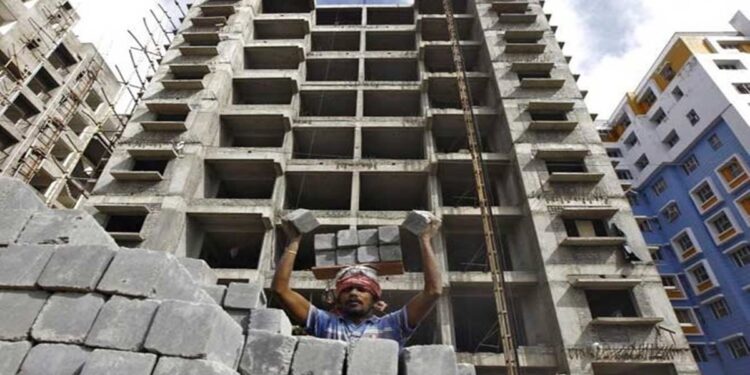The latest GDP data suggest GVA in construction shrank 2.8% in real term in the third quarter from a year before.
Construction activities in the real estate space remain under pressure and are down by a quarter from the pre-pandemic levels, partly as small and medium developers continue to face a liquidity squeeze in the wake of the Covid outbreak. Rising input costs and a labour shortage in many cities and towns have just exacerbated the woes of builders.
The latest GDP data suggest gross value added (GVA) in construction, including overall infrastructure-building and other such activities, shrank 2.8% in real term in the third quarter from a year before. It underperformed a 4.7% jump in overall GVA growth, as a favourable base effect waned and heavy rainfall lashed some southern states. Of course, in nominal terms, it went up by 16.3% in the December quarter, reflecting elevated inflationary pressure in this segment. In fact, the construction sector — which had remained under pressure even before the pandemic spread its tentacles — will likely contract again in the March quarter in real term, some economists apprehend, pointing at an unfavourable base effect. The sector had grown 14.5% in the fourth quarter of the last fiscal, partly due to sustained infrastructure push by the government to reverse a slide in economic growth, they added.

The recent production data of cement and steel also throw up a mixed trend. Cement output grew by 13.9% and 13.6%, respectively, in December and January. But steel production dropped 0.7% in December and grew just 2.8% in January, according to the government data on key infrastructure industries. Pankaj Kapoor, founder and managing director, Liases Foras, said the construction activity in real estate has not gone back to the pre-pandemic levels. “Though the new launches have increased substantially, and volumes of sales have improved on the back of stamp duty reductions and low interest rates, barring the branded and listed developers, other small to mid-sized developers are facing challenges on construction cycles,” he added.
The construction activity in real estate continues to be slow and is 25-30% lower than the pre-pandemic level. Reduced cash flows and delayed payments to contractors have also slowed down construction in some cases, Kapoor said.
Anuj Puri, chairman of Anarock Group, said overall construction activities during the festive quarter (October-December) slows down due to labourers — including those working on infrastructure projects and residential and commercial buildings — return to their hometowns to celebrate the festivals. “On the real estate front, maximum launches took place over the festive quarter, but slowdown in the infrastructure segment will have impacted overall construction,” Puri said.
In fact, the contraction in construction GVA in Q3 is also attributable to a decline in the pace at which highways are built. Construction of highways fell to a four-year low of 22.2 km per day during the April-January period of the current financial year, mainly because multiple cyclones and heavy rains affected construction in the southern states in recent months. Data from the ministry of road transport and highways (MoRTH) showed that barring during April and December, highway construction fell on year in all the other months in the April-January period of this fiscal year, with the sharpest fall in January. While 1,929 km of highway stretches were constructed in January 2021, construction stood at just 499 km in January 2022.
(With inputs from Surya Sarathi Ray in New Delhi)














